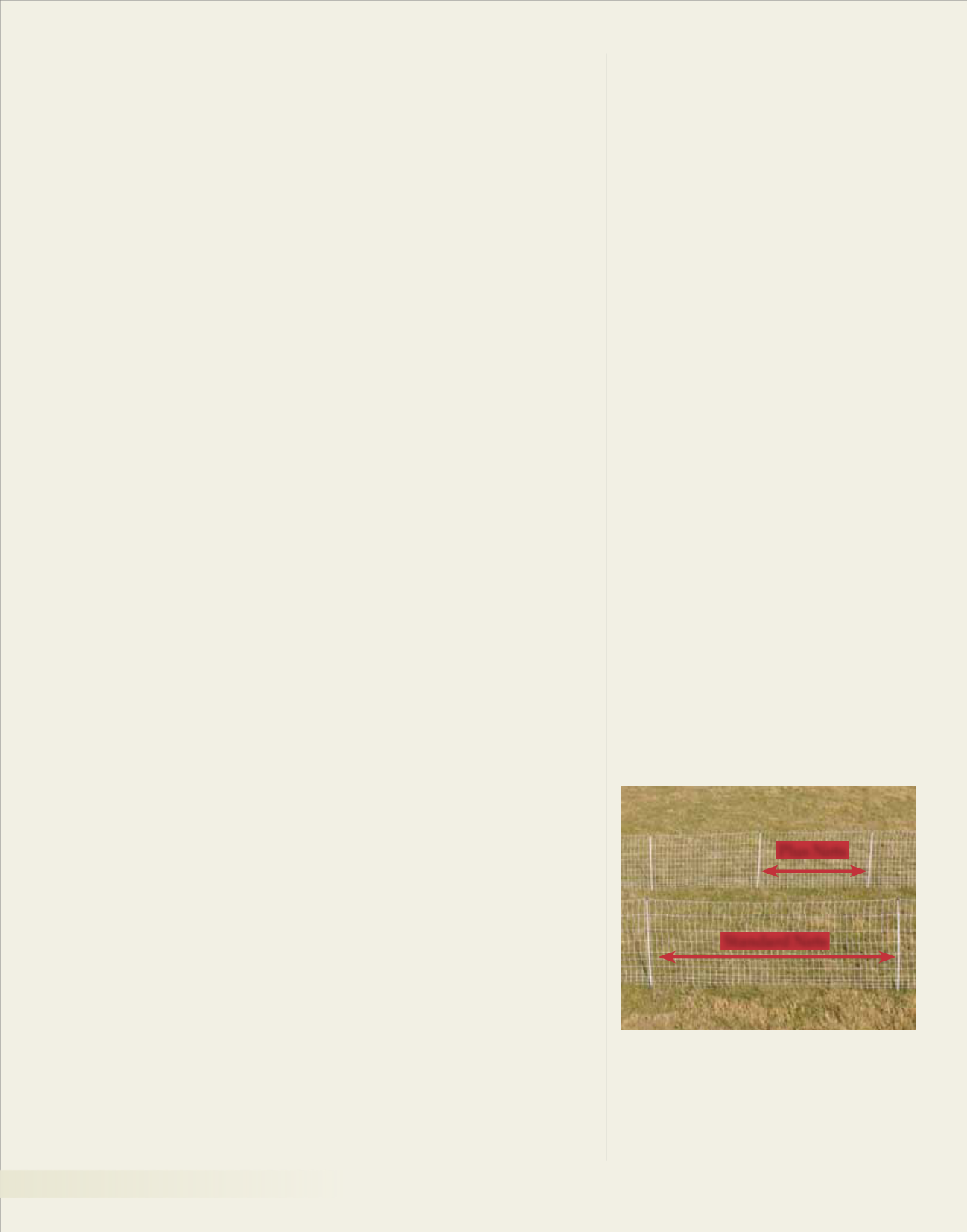
Plus nets (back) have a shorter distance between the
posts than standard nets (front). This reduces potential
sagging at curves and corners.
Netting changes
through the years…
Premier first imported netting in
1977 when Stan Potratz (Premier’s
founder) returned to the family farm
after farming for 10 years in England.
The original netting was yellow
and black, 33" tall, 150 ft long, a poor
conductor (compared to our nets now)
and used thin 0.50" diameter posts.
During the past 37 years we’ve
talked daily to netting users about
what they like and dislike about it.
We’ve used netting extensively (2
miles of it currently) on our 3 small
farms—and have our own likes and
dislikes. As a result we’ve:
• Developed better netting designs.
• Become the world’s leading
educator on the uses and abuses of
electrified netting.
• Supplied 80% of the USA’s netting.
Since 1977 we’ve introduced:
• Black/white horizontal strands
for their higher visibility.
• Higher conductivity.
Reduced
electrical resistance per 1000 ft from
380
Ω
to 38
Ω
.
Now almost essential
for long fences and those that
experience high weed contact.
• Larger, stiffer line posts—
0.60"
and 0.75" diameter instead of 0.50".
• Plus nets with extra posts.
• Designs for specific species.
• Better support spikes
.
• Double spikes
if you prefer them.
• More secure caps and clips.
• Reliable Pos/Neg designs.
• QuikFence
—
a suspended netting
that doesn’t rest on the soil.
• FiberTuff posts
for corners, curves.
•
New!
Drivable netting posts.
Can
be hit with a hammer for hard soils.
We noticed that some “net” users added
extra line posts to their nets.
That made sense since we too have
encountered sites that require less space
between the posts.
So we asked our net manufacturer to
supply us nets with extra posts
(see photo below)
in them. We call them
Plus nets.
Their advantages:
1. Reduce sagging between posts.
Sagging can be a problem for nets with
many horizontals and verticals
(e.g. PoultryNet).
2. Better, faster fencing for curves/corners
and across dips/hills.
Their negatives:
1. Same length of Plus net weighs more.
2. Same length of Plus net costs more—
but less than the total cost when users
add their farmstore nonstandard posts.
Designs with Plus options…
ElectroNet Plus 9/35/12............... pp. 20–21
ElectroStop Plus 10/42/12............ pp. 24–25
ElectroFence Plus 11/48/12................... p. 27
PermaNet Plus 12/48/3................ pp. 50–51
PoultryNet Plus 12/42/3............... pp. 32–33
PoultryNet Plus 12/48/3............... pp. 34–35
PermaNet Plus 12/48/3....pp. 36–37, 50–51
VersaNet Plus 9/20/3.................... pp. 44–45
VersaNet Plus 11/30/3.................. pp. 46–47
VersaNet Plus 12/60/3.................. pp. 52–53
About
Plus Nets…
Electrified netting, in its many
variations, has been such an essential
tool on our farms since 1978 that it is
difficult to imagine life without it.
That others share this view is
proven by the demand for it from
goat and sheep owners across
North America. We were the first
to introduce it to the US and now
supply 80% of all netting that’s in use
in this country.
Before netting…
• Sheep could only be grazed in
areas enclosed with woven wire.
With netting they can be
grazed nearly anywhere that
folks want to install the nets.
• Sheep were at the mercy of
coyotes and stray dogs. It was
not a matter of
if
, but
when
.
Shepherds had to sleep with one
ear open.
With netting we can keep the
coyotes out and our guard dogs
in. (We need both netting and
dogs to stop the local coyotes.
A fence that’s changed sheep and goat husbandry
for many US producers…
The netting ensures dogs stay in and
the combination of net plus dogs
ensures coyotes stay out.)
• One person could not move more
than 50 head of sheep without a
herding dog.
With netting to make temporary
lanes, one careful person can control
and move a reasonably large flock
without a herding dog.
• Using sheep or goats for weed and
brush control by forcing them to eat a
minimal area with specific vegetation
was rarely practical.
Premier’s netting enables goats and
sheep to—
a
Browse brush under power lines.
a
Eat brush to prevent it from
becoming fuel for wildfires.
a
Control invasive species (e.g.
leafy spurge, garlic mustard).
a
Reclaim acres infested with
multiflora rose and other brushy/
undesirable weeds.
• Flood gaps rarely contained sheep,
goats or guard dogs.
They do now—if the netting is reset
after each flood.
10 NETTING FAQs
www.premier1supplies.com• 1-800-282-6631
Plus Nets
Standard Nets









